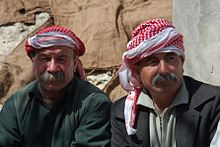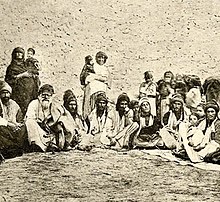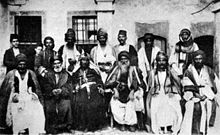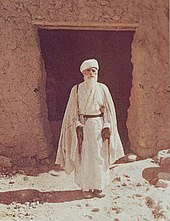Yazidis
The Yezidis ( ![]() ) or Yezidis (Kurmanji ئێزیدی Êzîdî) are a mostly Kurmanji speaking ethno-religious minority with about one million members, whose original main settlement areas are in northern Iraq, northern Syria and southeastern Turkey. The Yazidis consider themselves partly as ethnic Kurds, partly as a separate ethno-religious group. Currently, Yazidis are recognized as a distinct ethnic group in Armenia and Iraq. The State Department refers to the Yezidis as an "ethnic minority." Today, Yazidis are spread to other countries through emigration and flight. Due to persecution by Kurds, many Yazidis fled to Armenia and Georgia in the 19th and early 20th centuries. With an estimated 200,000 members (2017), the Yazidis in Germany form the largest diaspora community of the Yazidis.
) or Yezidis (Kurmanji ئێزیدی Êzîdî) are a mostly Kurmanji speaking ethno-religious minority with about one million members, whose original main settlement areas are in northern Iraq, northern Syria and southeastern Turkey. The Yazidis consider themselves partly as ethnic Kurds, partly as a separate ethno-religious group. Currently, Yazidis are recognized as a distinct ethnic group in Armenia and Iraq. The State Department refers to the Yezidis as an "ethnic minority." Today, Yazidis are spread to other countries through emigration and flight. Due to persecution by Kurds, many Yazidis fled to Armenia and Georgia in the 19th and early 20th centuries. With an estimated 200,000 members (2017), the Yazidis in Germany form the largest diaspora community of the Yazidis.
Yezidis practice strict endogamy. Yezidism is a monotheistic, syncretic religion not based on sacred scripture. Membership is by birth only, if both parents are of Yazidi descent. Marriage of Yazidis (of either sex) to non-Yazidis results in expulsion from the community, given Yazidi marriage rules. At the center of the Yazidi faith are Melek Taus ("Angel Peacock"), Shaykh ʿAdī ibn Musāfir (c. 1073-1163), and the seven mysteries. Sheikh ʿAdī's tomb in Iraq's Lalish Valley is the main shrine of Jesidism and the destination of an annual pilgrimage in the fall.
Since August 2014, the Yazidis have been victims of an ongoing genocide. As so-called "infidels", they are fleeing persecution, enslavement and murder by the terrorist fundamentalist militia Islamic State in northern Iraq.

Yezidi men, traditional with moustache

A group of Yazidis on the Sinjar mountain range in the Syrian-Iraqi border region (c. 1920)

A meeting of Yezidi tribal leaders with Christian Chaldean clerics (late 19th century).
Origin of the designation
Yezidis are also called Yezidis or Yezidis. The majority of Yezidis living in Germany use the ethnonym "Yezidis" or "Êzidis" as their own name and tend to avoid the foreign names "Yezidis", "Yazidis" or "Yezidis". The origin of the term Êzîdî is still unclear. Some scholars trace the name Yazidi back to the Umayyad caliph Yazid I ibn Muawiya (680-683). Yezidis reject a relationship between their names and the caliph. Instead, some Yezidis, like other scholars, often trace the designation to the Old Iranian word yazata for "divine being," thus at the same time establishing a connection with the Old Iranian god Ahura Mazda, which makes them "god-worshippers" by name. The religious scholar ash-Shahrastani (1076-1153) traced the name of the Yezidis to the Kharijite cleric Yazid bin Unaisa, whose followers they had been. Another derivation of the word's origin uses the reference to Ez dā ("create me"). Yazidis also refer to Xwedê ez dam ("God created me") and to Em miletê ezdaîn ("We are the Ezdayi nation").

Yezidi chief in Bashiqa (1910s, photo by Albert Kahn)
Number and main settlement areas
→ Main article: Ezidchan
The original settlement areas of the Yazidis are located in northern Mesopotamia and are also referred to as Ezidchan (Land of the Yazidis). There is no official census of the Yazidis. Their number is estimated at over one million worldwide. The majority are the Yazidis living in Iraq with half a million members. In Germany live about 200,000, in the rest of Europe there are about 65,000 more. In the USA and Canada live a few thousand Yazidis, mostly from Iraq. More than 35,000 live in Armenia, and Yazidis also live in Georgia and Russia. In Syria live a few thousand and in Turkey over 2000 mostly in Southeast Anatolia. In the 1980s, there were about 60,000 Yazidis living in Turkey. The Yazidis are thus today a religious minority among the majority Muslim population of the Middle East.
The native language of the Yazidis is the northwestern Iranian language Kurmanji. Arabic is spoken only in the Yazidi villages of Baʿšiqa and Baḥzānē in the disputed areas of northern Iraq.
The largest number of Yazidis live in northern Iraq. The Yazidis are essentially spread over two areas here. One is the Shaykhān region northeast of the city of Mosul. Here are Lalish, the religious center of the Yazidis, the village of Baʿadhrā, where the Mīr of Shaykhān, the secular and spiritual leader of the Yazidis, resides, and the two villages of Baʿshīqa and Bahzānē, which are considered the scholarly centers of the Yazidis. The second main Yazidi settlement area is the mountain range of Jabal Sinjar west of Mosul on the border with Syria, but many Yazidis also live in the city itself. The Baath Party under Saddam Hussein declared the Yazidis in northern Iraq to be Arabs during its Arabization campaign in the 1970s and 1980s.
Due to the advance of the jihadist ISIS army (Islamic State in Iraq and Syria) in July and August 2014, many Yazidis fled from Mosul and the surrounding area to the Kurdish area around the city of Erbil and to the Sinjar Mountains.
Censuses and estimates by the Turkish, British and Iraqi sides from the 1920s gave a Yazidi proportion of 4 to 7 per cent of the Iraqi Kurds, which today would correspond to 160,000 to 350,000 persons if the proportion remained the same. Some maximum estimates today put the number of Yazidi believers as high as 550,000. The Yazidis make up an estimated 1 percent of the Iraqi population. Since 1991, the Yazidi community in Iraq has been divided in two. 90 percent of Iraq's Yazidis live in Iraqi-administered territory and only about 10 percent in Kurdish-administered territory.
In northern Syria, Yazidis live primarily in Afrin and in northeastern Syria primarily in and around the city of Qamishli and in al-Hasakah governorate. However, their numbers declined considerably. One estimate puts their number at 12,256 in 1990, but only 3,357 at the end of 2008. Other estimates put their number at between 35,000 and 50,000. It is declining due to emigration to Europe.
In the 1830s, after the end of the Russo-Turkish War in 1828/29, the first Yazidis arrived from Anatolia to Eastern Armenia, which was part of the Russian Empire. In 1855, about 340 Yezidis were counted in the Sardarabad district (roughly present-day Armawir). Several thousand Anatolian Yazidis were settled in the late 19th century in Shirak province, among other places. In 1912, over 17,000 Yazidis lived in the territory of present-day Armenia. In the 2001 census, their number was 40,000. In 2011, they constituted the largest minority in the country, accounting for 1.1 percent of the total population. Their cultural centre in the province of Aragazotn was the village of Alagyaz during the Soviet period.

Yezidis in the Jabal Sinjar
Search within the encyclopedia